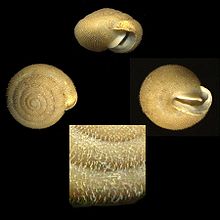





The periostracum (/ˌpɛriˈɒstrəkəm/ PERR-ee-OS-trə-kəm) is a thin, organic coating (or "skin") that is the outermost layer of the shell of many shelled animals, including molluscs and brachiopods. Among molluscs, it is primarily seen in snails and clams, i.e. in gastropods and bivalves, but it is also found in cephalopods such as Allonautilus scrobiculatus. The periostracum is an integral part of the shell, and it forms as the shell forms, along with the other shell layers. The periostracum is used to protect the organism from corrosion.
The periostracum is visible as the outer layer of the shell of many molluscan species from terrestrial, freshwater, and marine habitats, and may be seen in land snails, river mussels, and other kinds of freshwater bivalves, as well as in many kinds of marine shelled molluscs.
The word periostracum means "around the shell", meaning that the periostracum is wrapped around what is usually the more calcareous part of the shell.[1] Technically, the calcareous part of the shell can (at least in theory) be referred to as the "ostracum", but that term is only very rarely used.
- ^ "periostracum". Dictionary.com Unabridged (Online). n.d. Retrieved 2015-05-10.